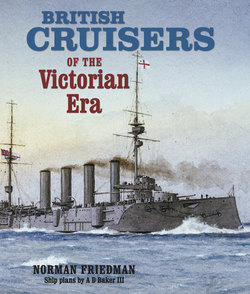Читать книгу British Cruisers of the Victorian Era - Norman Friedman - Страница 8
На сайте Литреса книга снята с продажи.
ОглавлениеAcknowledgements
My wife Rhea made this book possible. She helped me think through some of the key issues concerning dramatic changes in British exposure to trade warfare, which are vital to its thesis. As the scope of this book expanded to embrace the whole Victorian era (and a few years afterwards), I had to go back to various archives again and again, and Rhea encouraged me to do so. I could not have written this book without Rhea’s loving support and encouragement.
Any project like this book benefits enormously from the help friends can provide. This one particularly benefited as its time scope grew from the late Victorian era (beginning with HMS Iris and Mercury). Anyone who has worked in the documents of this period will recognize that the extent and quality of documentation declines dramatically for the period before about 1870. For example, no policy documents explain the dramatic cut in cruiser construction in 1863-64. None of the Covers for the big iron frigates appear to have survived (it is as though Edward Reed decamped with all of his design documentation when he stepped down as DNC). I am therefore particularly grateful to those who helped with what documentation has survived. Dr Stephen S Roberts generously provided British material he had collected many years ago for his thesis on French naval development. Professor John Beeler, who is collecting and publishing the Milne papers, provided some key letters. Professor Andrew Lambert, who has specialized in the Victorian Royal Navy, generously provided several papers, one of them unpublished. Chris Wright, editor of Warship International, provided his thesis on the Royal Navy of this period, which greatly helped clarify the policy context. I benefited enormously from a lengthy conversation with Colin Jones and with John Houghton, and the latter generously provided a copy of his book on world navies of the early Victorian period.
For both the early and the later eras, I am grateful to Jeremy Michell and to Andrew Choong of the Brass Foundry outstation of the National Maritime Museum for their enormous help with plans and photos. I am also grateful to Bob Todd, photo curator at the Brass Foundry. For photos held by the US Navy, I would like to thank my friend Charles Haberlein, curator emeritus at the Naval Historical and Heritage Command, and his assistants Ed Finney and Robert Hanshew (who is Mr Haberlein’s successor). I would like to thank the photo library staff of the US Naval Institute. I am grateful to the State Library of Victoria (Australia), which has made available the superb photography of Allan C Green which it holds. I am also grateful to the staff of the Public Record Office (now called the National Archives) at Kew and to Jennie Wraight, Admiralty Librarian at the Royal Navy Historical Branch in Portsmouth. I would like to thank Dr David Stevens of the Royal Australian Navy Historical Branch and Dr Josef Strazcek, formerly his assistant and an avid photo collector. Both supplied very useful photographs. Stephen McLaughlin very generously provided material on Vickers designs. I can only regret that no comparable record of Armstrong designs seems to have survived. That is particularly unfortunate because Armstrong built the great bulk of the export cruisers of the period covered by this book. I was fortunate to be permitted to use the Vickers collection at Cambridge University Library.
My good friend A D Baker III is listed as illustrator, but he is much more than that. As he painstakingly created drawings of British cruisers, he pointed out their many quirks and the relationships which he could see in the source drawings and photographs. Often they were not evident in other documentation. Mr Baker also kindly provided some of the photographs in this book. Both Mr Baker and I much appreciate the advice and assistance we received from our friend Alan Raven in the course of this project. I would like to thank Paul Webb for the drawings he contributed. I would like to thank Professor Jon Sumida not only for his assistance with this project, but for illuminating, many years ago, the economics of the Royal Navy – which for me explained a lot of what is described in this book.
As grateful as I am for the assistance I received, I am of course responsible for the contents of this book, including any errors.
NORMAN FRIEDMAN
